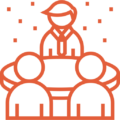Competences and experience enable the What an individual can do.
The attitudes of an individual go to the very essence of
Why they do what they do and How they will do it.
It is in these aspects of attitude, especially where there is fit between the individual and the organisation, that high performance has the best opportunity to occur.
People with wrong attitudes:
- Are tough to manage
- Can distract you from focusing on more important tasks
- Can be irritating for you and the team
- Can contaminate your organisation with negative atmosphere
- Can reduce performance
- Are difficult to exit
Most organisations use some form of Competency Framework but this only defines 'WHAT' an employee has to do and what they need to know in order to do it. It is the Attitude Framework that answers the 'WHY' and 'HOW' questions. It ensures that your new hire's personal 'Why' and 'How' fits those of your organisation. A misfit will degrade the personal performance of the new employee as well as that of your organisation.
Perfect People never loses sight of the fact that skills, competence, experience etc. are of major importance - for the 'What'. Nonetheless, there is a huge (and increasing) body of research, articles and real-life stories around the criticality of attitudes.
However, once you have whittled down your two hundred applicants to a ‘long list’ of equally skilled, competent and experienced people how do you get to short list and eventually your final choice? How do you tell the difference between the candidate who will help you produce stellar results from the one that may destroy you despite the apparent competence on paper?
This is where attitudes become the critical aspect to understand in any prospective new hire.
When reducing a 'long list' of apparently equally competent, qualified and experienced people to a 'short list' it is Attitudes and Fit that make the difference between the new hire that boosts performance over the long term or one that 'quits but stays'.
Benefits of drawing up an Attitude Audit Framework

Provides a complete picture of attitudinal requirements for a given position; it shows what it takes to be a high performer in your organisation; interviewers have a clear guidance as well as a picture of the behaviours they are looking for in every candidate.

Helps the productivity and profitability of the organisation by preventing it from choosing candidates with wrong attitudes who have little interest, drive or motivation to manage the organisation to a higher level.

Increases the likelihood of selecting people who fit the job and who will most likely succeed in their positions and do the job effectively.

Attitudes are contagious. Selecting the right ones can revitalise those around the new individual. Selecting the wrong ones can lead to decreasing morale and performance.

Identifies attitudes which are required for the role and which strongly correlate with high job performance.

Saves the company from high churn, lost productivity and increased replacement costs.
Attitudes are a combination of both ‘hard wired’ personality traits and behaviours that are learned as part of external experiences. They are individual's signature strengths or weaknesses.
Attitudes lead to certain behaviours and can be strong predictors of how someone will respond in any given situation over time.
Charisma, courage, humour, kindness, resilience, persistence, determination, a helpful attitude, developing others etc. are all qualities one might desire in an employee.

